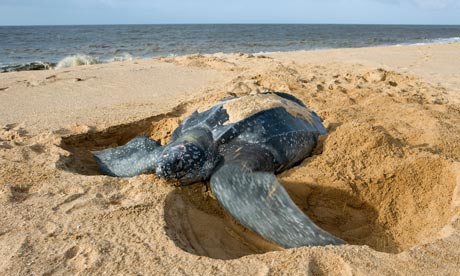Human activity is driving Earth’s ‘sixth great extinction event’
Population growth, pollution and invasive species are having a disastrous effect on species in the southern hemisphere, a major review by conservationists warns
- guardian.co.uk, Tuesday 28 July 2009 19.24 BST
- Article history

The leatherback turtle is endangered – but scientific reports expose worrying signs of mass extinctions among other wildlife species. Photograph: Frans Lemmens/Getty Images
Earth is experiencing its “sixth great extinction event” with disease and human activity taking a devastating toll on vulnerable species, according to a major review by conservationists.
Much of the southern hemisphere is suffering particularly badly, and Australia, New Zealand and neighbouring Pacific islands may become the extinction hot spots of the world, the report warns.
Ecosystems in Polynesia, Micronesia and Melanesia need urgent and effective conservation policies, or the region’s already poor record on extinctions will worsen significantly.
Researchers trawled 24,000 published reports to compile information on the native flora and fauna of Australasia and the Pacific islands, which have six of the most biodiverse regions on the planet. Their report identifies six causes driving species to extinction, almost all linked in some way to human activity.
“Our region has the notorious distinction of having possibly the worst extinction record on Earth,” said Richard Kingsford, an environmental scientist at the University of New South Wales in Sydney and lead author of the report. “We have an amazing natural environment, but so much of it is being destroyed before our eyes. Species are being threatened by habitat loss and degradation, invasive species, climate change, over-exploitation, pollution and wildlife disease.”
The review, published in the journal Conservation Biology, highlights destruction and degradation of ecosystems as the main threat. In Australia, agriculture has altered or destroyed half of all woodland and forests. Around 70% of the remaining forest has been damaged by logging. Loss of habitats is behind 80% of threatened species, the report claims.
Invasive animals and plants have devastated native species on many Pacific islands. The Guam Micronesian kingfisher is thought to be extinct in the wild following the introduction of the brown tree snake. The impact of invasive species is often compounded by pollution and burgeoning human populations on the islands, which have outstripped their capacity to deal with waste. Plastics and fishing gear are an ongoing danger.
The impact of humans on wildlife is likely to increase in Australasia and the Pacific islands. By 2050, the population of Australia is expected to have risen by 35%, and New Zealand by 25%, while Papua New Guinea faces a 76% increase and New Caledonia 49%.
More than 2,500 invasive plant species have colonised Australia and New Zealand, competing for sunlight and nutrients. Many have been introduced by governments, horticulturists and hunters. In addition, the report says, average temperatures in Australia have increased, in line with climate change predictions, forcing some species towards Antarctica and others to higher, cooler ground.
The report highlights several studies that point to serious threats from diseases such as avian malaria and the chytrid fungus, linked to declines in frog populations. An infectious facial cancer is spreading rapidly among Tasmanian devils and populations of the world’s largest marsupial predator are believed to have fallen by more than 60% as a result.
Plants have also fared badly: a root fungus deliberately introduced into Australia has destroyed several species.
The report sets out a raft of recommendations to slow the decline by introducing laws to limit land clearing, logging and mining; restricting deliberate introduction of invasive species; reducing carbon emissions and pollution; and limiting fisheries. It raises particular concerns about bottom trawling, and the use of cyanide and dynamite, and calls for early-warning systems to pick up diseases in the wild.
“The burden on the environment is going to get worse unless we are a lot smarter about reducing our footprint,” said Kingsford. “Unless we get this right, future generations will surely be paying more in quality of life and the environment. And our region will continue its terrible reputation of leading the world in the extinction of plants and animals.”
Dead and buried
Cretaceous-Tertiary 65m years ago, the dinosaurs were wiped out in a mass extinction that killed nearly a fifth of land vertebrate families, 16% of marine families and nearly half of all marine animals. Thought to have been caused by asteroid impact that created Chicxulub crater in the Yucatan.
End of Triassic About 200m years ago, lava floods erupting from the central Atlantic are thought to have created lethal global warming, killing off more than a fifth of all marine families and half of marine genera.
Permian-Triassic The worst mass extinction took place 250m years ago, killing 95% of all species. Experts disagree on the cause.
Late Devonian About 360m years ago, a fifth of marine families were wiped out, alongside more than half of all marine genera. Cause unknown.
Ordovician-Silurian About 440m years ago, a quarter of all marine families were wiped out by fluctuating sea levels as glaciers formed and melted. again.
